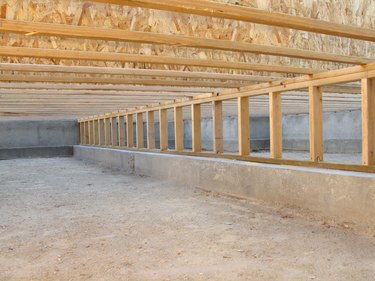
If your house is on low stilts or has a crawl space, the underside is prone to mold, including toxic black mold. These areas are often dark, poorly ventilated and damp, which are the perfect conditions for a mold infestation. While treating mold is usually a simple procedure, in this case it is complicated by the need to do the job in a cramped space; special care is necessary to treat black mold under a house properly and safely.
Things You'll Need
Video of the Day
How to Treat Black Mold Under a House
Step 1: Put on Protective Gear
Put on protective gear, including a respirator with mold-blocking filters, safety goggles, gloves, long sleeves, long pants and closed-toe shoes or boots. After completing the job, strip and wash all of the clothing in hot water and laundry detergent immediately. Also, clean the rest of your gear to remove mold spores; remove the respirator and safety goggles last to protect your lungs and eyes. Shower and wash your hair to remove any lingering spores.
Video of the Day
Step 2: Add Ventilation to the Space
Ventilate the underside of your house by rigging a GFCI heavy-duty three prong-outlet cord with an additional outdoor extension cord and one or more box fans so they blow the air out of the crawl space. Treating black mold will release its spores into the air, and blowing these spores from out of the underside of your house is essential.
Step 3: Mix a Mold-Killing Solution
Mix a treatment solution in a bucket, using 1 cup of Borax per 1 gallon of water. Pour this into your spray bottle with the funnel. In a confined, vertical workspace like the underside of your house, your treatment solution will inevitably drip down onto your face. You should use Borax instead of bleach, as it is a powerful cleanser but not nearly as toxic.
Step 4: Remove Contaminated Materials
Remove any spongy materials that have been infested with black mold, such as insulation or gypsum board. These materials cannot be treated and should be discarded and then replaced. Also, look for rodent and insect infestations; remove contaminated or damaged materials and treat for the pests.
Step 5: Saturate Infested Areas
Saturate the black mold infestation on the underside of your house with the Borax solution, and allow that to sit in place for roughly three minutes. In the case of an infestation on brick, which has a porous surface, wait for five minutes.
Step 6: Scrub the Mold Off
Scrub the mold from the moldy areas with your scrub brush. Wipe away the resulting scuzz with a wet rag.
Step 7: Set Up a UV Lamp
Rig another extension cord and set up a ultraviolet (UV) lamp under your house, so that the UV rays bombard the moldy area. UV lamps offer a good substitute for mold-killing sunlight. Leave the lamp in place and the fans blowing overnight to guarantee that all spores under your house have either been flushed out or killed. Do not look directly at the lamp; the UV rays can harm your eyes.
Step 8: Inspect the Results
Return to the underside of your house the next day and inspect the results of the treatment. If there is any black mold remaining, repeat the procedure. Continue to inspect regularly to avoid mold regrowth.
Step 9: Remove Moisture Sources
Look for moisture sources, whether leaking pipes, landscaping that directs rain and irrigation water toward the foundation or a high water table. To permanently remedy any mold problem, you must address the factors that encourage mold growth. Mitigate mold issues by fixing pipes, redirecting gutters and rainwater, adding French drains outside of the foundation or installing a sump pump.